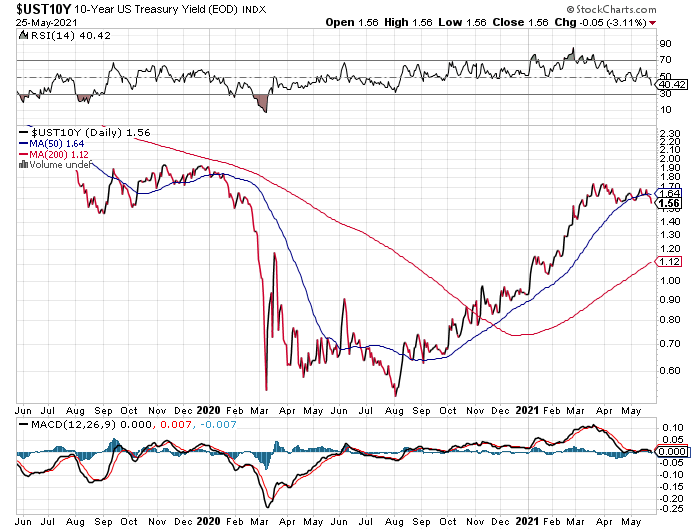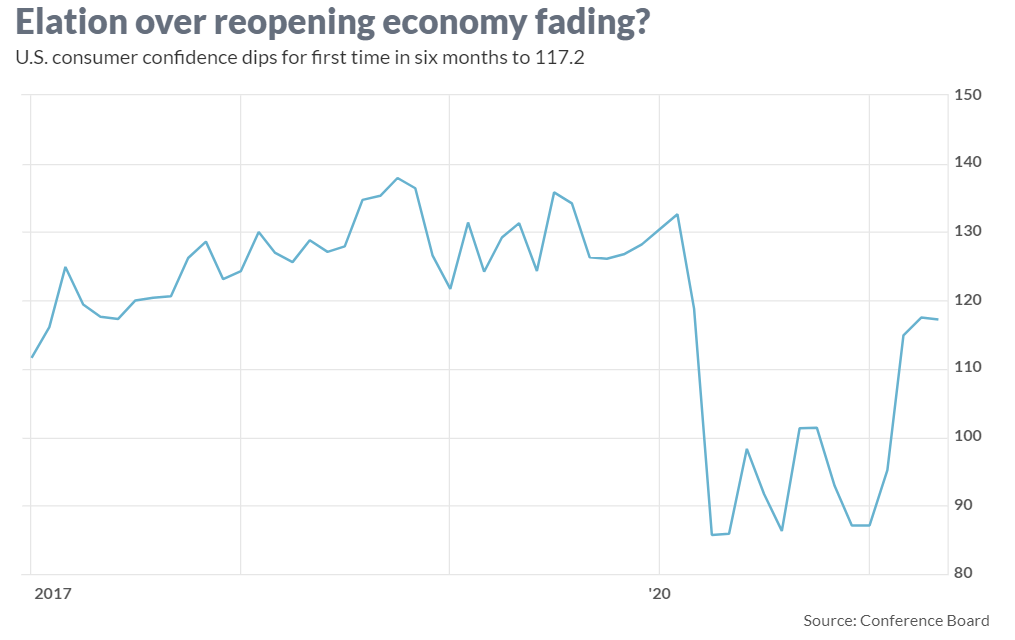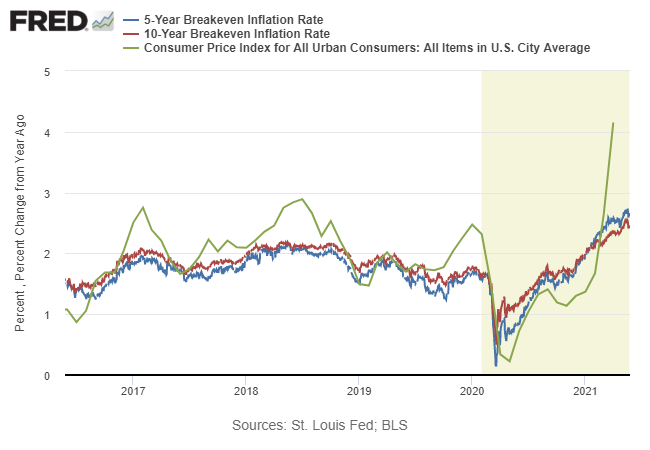After rebounding sharply from pandemic lows, the 10-year Treasury yield is nearly back to levels that prevailed before COVID-19 began to roil the global economy in early 2020.
But the 10-year rate has been in a holding pattern for the past two months, raising questions about what happens next.
Markets are forward-looking and so the Treasury market began pricing in recovery and reflation in 2020’s second half. The repricing ran its course in 2021’s first quarter and remains on hold as investors consider the outlook for inflation and economy.

The rear-view mirror certainly paints a bright picture. Economic growth accelerated to 6.4% gain (annualized real rate) in this year’s first quarter and is on track to run even hotter in Q2. The Atlanta Fed’s GDPNow model, for example, estimates output will surge to a red-hot 10.1% pace (based on the May 18 estimate).
A stronger run of growth in Q2 will keep the recovery narrative humming, but such a pace isn’t sustainable and probably will mark a peak for the cycle (ignoring the off-the-charts 33% surge in 2020’s Q3 due to the one-time bounce-back effect from the depths of the pandemic).
Even if the economy tops out in Q2, the expansion will remain healthy for the foreseeable future. But as US government stimulus spending fades, economic activity will continue to normalize—a shift that the Treasury market seems to be anticipating.
Using the 10-year rate as a guide, the Treasury market is pricing in a future of moderating growth and inflation data. Incoming numbers, as always, could upend this implied forecast, but for the moment the market seems to be anticipating the US will move closer to picking up where it left off before the pandemic struck.
The wild card is inflation, which rebounded sharply in April, based on the consumer price index. The great debate is whether this surge is temporary or the start of an enduring run of hotter inflation. A convincing answer won’t be known for months.
Meanwhile, rest assured that every monthly CPI update will be closely read and debated as the crowd looks for fresh clues, starting with the June 10 release of May inflation data.
Another key indicator to watch: consumer spending. Some analysts advise that the recent surge in household savings, driven by relatively generous government stimulus and unemployment support, will fuel a consumption binge.
In turn, that will push economic growth and inflation higher. But the latest numbers paint a mixed picture on this front, suggesting that the propensity to save may be stickier than previously thought.
One clue for this line of thought: US retail spending was unexpectedly weak in April, posting no change after a surge in March.
Yesterday’s update of the US Consumer Confidence Index for May suggests that consumer spending could remain relatively muted for this month too. The Conference Board’s sentiment benchmark retreated for the first time in six months, suggesting that a full recovery for the mood on Main Street is still a ways off.

“Consumers’ assessment of present-day conditions improved, suggesting economic growth remains robust in Q2,” says Lynn Franco of the Conference Board. “However, consumers’ short-term optimism retreated, prompted by expectations of decelerating growth and softening labor market conditions in the months ahead.”
To be fair, macro data have been unusually noisy lately, which complicates efforts to search for reliable trends of late. Nonetheless, economists at Jeffries advise in a research note that “We are not going to see the same sort of boost from hope [and] expectations going forward,” which appears to be reflected in the moderating consumer confidence data.
The 10-year Treasury yield is pricing in a period of mixed results for the economic outlook. Between stimulus spending and the natural forces of recovery after economic lockdown, the US is enjoying a strong bounce.
But it’s reasonable to assume that much of the growth has been pulled forward, setting the economy up for a bit of a hangover in 2021’s second half and into early 2022.
Hotter inflation could change the calculus with respect to rates, but at the moment the Treasury market is anticipating that consumer inflation will trend at around 2.5% a year, roughly in line with the pace before the pandemic hit, based on breakeven rates.
In other words, the market is predicting that the April surge in CPI will moderate.

Note, too, that the Treasury market’s inflation curve for 5- and 10-year maturities is sloping down, another indication that the market’s anticipating that inflationary pressures will ease after the current reflation runs its course.
Forecasts should be taken with a grain of salt, of course, and the Treasury market’s outlook is no exception. Regardless, the great reflation trade is on hold and the bond market is asking for more evidence that inflation will be more than transitory.
One possibility is that higher inflation will be its own self-correcting mechanism on moderating economic activity, which in turn may cool pricing pressures.
“Economic activity is getting back to where it was before the pandemic hit,” observes Joel Naroff, chief economist at Naroff Economics in Holland, Pennsylvania. “So why aren’t people more exuberant? We might want to start blaming inflation.”
